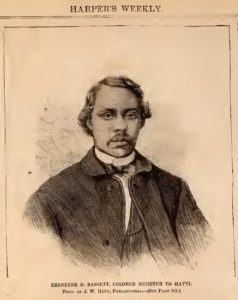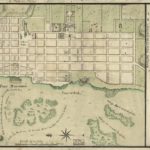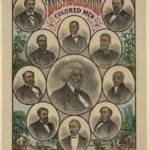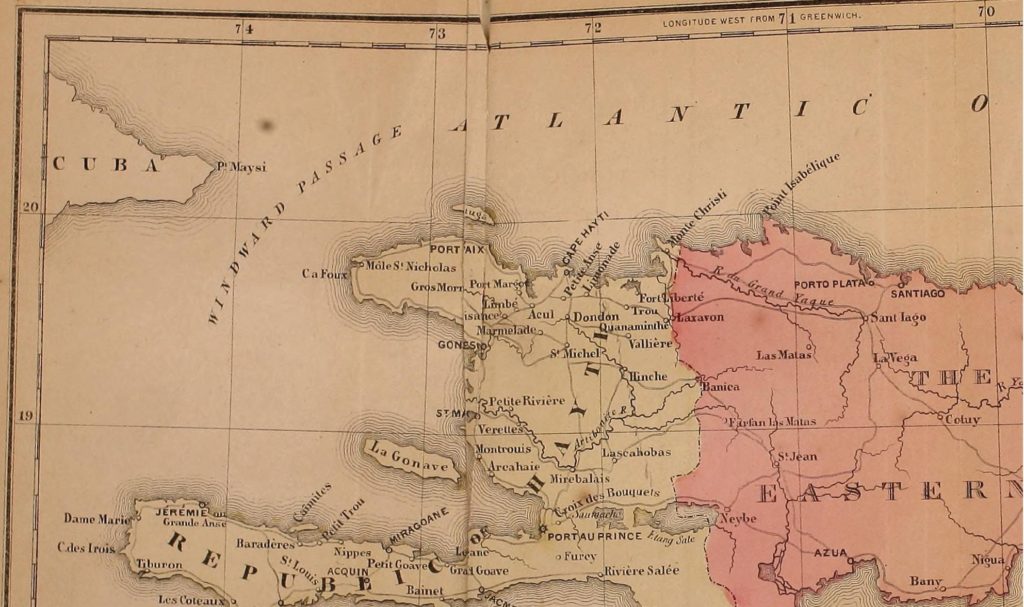From the May 1, 1869 issue of Harper’s Weekly:
EBENEZER D. BASSETT.
Very fitly a colored man of the highest eminence has been appointed Minister from this country to Hayti. Mr. BASSETT, whose portrait we give on page 285, is a fine mathematician, and is well versed in classic literature. He has for some time been President of the “Institute for Colored Youth” in Philadelphia – a high school maintained by the philanthropy of the Quakers, where young negroes receive a college education gratis. Seventeen of Mr. BASSETT’S graduates are now teaching in Delaware.
According to the U.S. State Department, “President Ulysses S. Grant appointed Ebenezer Bassett as the U.S. Minister to Haiti and the Dominican Republic in 1869. He was the first African American to serve as a U.S. diplomat anywhere in the world.”
Mr. Bassett served as Minister to Hayti for the entire eight years of the Grant presidency. According to Black Past it wasn’t exactly a cushy post. During a Haitian internal conflict his home was under siege by Haitian troops for five months until “Bassett negotiated Canal’s [a former coup leader] safe release for exile in Jamaica.”
William S. McFeely touched on the Bassett appointment in his biography of Frederick Douglass. After President Grant took office black leaders were hoping to receive some appointments, especially to the black republic of Haiti. Mr. Douglass and others who were interested in the post each claimed disinterest and deferred to the other black leaders. When Grant named Bassett, George T. Downing asked Senator Charles Sumner to get Douglass nominated instead. “When the request went to the White House, Grant, laconically and accurately, reported that he was having too much trouble getting other appointments confirmed to withdraw one that seemed safe, and refused,”[1]
The map below of a good chunk of Hispaniola comes from 1861’s A Guide to Hayti, which you can find at HathiTrust. The book was edited by journalist and antislavery activist James Redpath, who, in 1860,
toured Haiti as a reporter and returned to the United States as the official Haitian lobbyist for diplomatic recognition, which he secured within two years. He simultaneously served as director of Haiti’s campaign to attract free black emigrants from the United States and Canada. His Guide to Hayti (1860) is an anthology of articles by various authors on a wide range of Haitian subjects. Redpath hoped that immigration of skilled blacks to Haiti would elevate conditions there and dispel racial prejudice in the United States. After the Civil War, he abandoned his ideas when he recognized that North American blacks preferred to remain at home.
toured Haiti as a reporter and returned to the United States as the official Haitian lobbyist for diplomatic recognition, which he secured within two years. He simultaneously served as director of Haiti’s campaign to attract free black emigrants from the United States and Canada. His Guide to Hayti (1860) is an anthology of articles by various authors on a wide range of Haitian subjects. Redpath hoped that immigration of skilled blacks to Haiti would elevate conditions there and dispel racial prejudice in the United States. After the Civil War, he abandoned his ideas when he recognized that North American blacks preferred to remain at home.
When the book was first published in 1860 there were a lot of unfree blacks in the United States. Mr. Redpath’s introduction sees hope in Haiti:
THERE is only one country in the Western World where the Black and the man of color are undisputed lords; where the White is indebted for the liberty to live to the race which with us is enslaved; where neither laws, nor prejudices, nor historical memories, press cruelly on persons of African descent; where the people whom America degrades and drives from her are rulers, judges, and generals; men of extended commercial relations, authors, artists, and legislators; where the insolent question, so often asked with us, “What would become of the Negro if Slavery were abolished?” is answered by the fact of an independent Nationality of immovable stability, and a Government inspired with the spirit of progress. The name of this country is HAYTI….
You can view all the Harper’s Weekly content from 1869 at the Internet Archive. From the Library of Congress: map of Port au Prince; Ebenezer Bassett is directly below Frederick Douglass in the picture of distinguished men; the main drag
- [1]McFeely, William S. Frederick Douglass. New York: W. W. Norton & Company, 1991. Print. page 270.↩




![Main St., Port-au-Prince, Hayti, W.I. (c[1901] ; LOC: https://www.loc.gov/item/2016798787/)](https://www.bluegrayreview.com/wp-content/uploads/2019/04/4a05445v-150x150.jpg)
